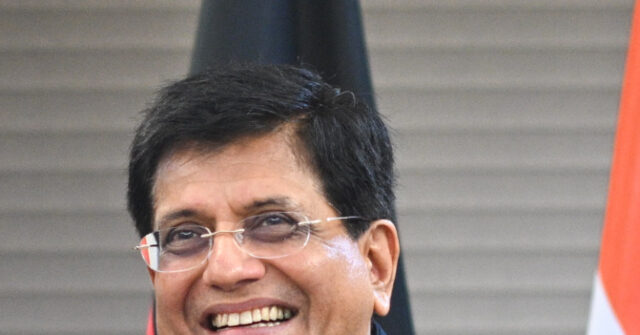Indian Commerce Minister Piyush Goyal said on Monday that President Donald Trump’s trade policies could create “the opportunity of a lifetime” for India.
“We stand at a moment in history where India is well-poised to convert the current situation into an opportunity,” Goyal told the India Global Forum in Mumbai.
Goyal described India as sympathetic to President Trump’s push for fairness in supply chains and eager to prove its fast-growing economy can step forward to take China’s place.
“If somebody was to ask me what would be the trigger point of where we are today and why we are going through this churn, the starting point of this actually goes to the beginning of 2000 when China was admitted as a member of the WTO,” he said.
Not many Western analysts in 2025 look back on China’s accession to the World Trade Organization (WTO) in 2000 with fondness, although varying degrees of criticism have been directed at the move. For stalwart supporters of President Trump’s “America First” policies, letting China into the WTO was one of the worst mistakes ever made by the free world.
The BBC headlined a 2021 retrospective on China’s WTO membership as “How the West Invited China to Eat Its Lunch.”
The article made light of former President Bill Clinton’s foolish belief, commonplace at the time, that letting China into the WTO would liberalize Beijing.
“When individuals have the power not just to dream, but to realize their dreams, they will demand a greater say,” Clinton rhapsodized in 2000.
Nothing could have been further from the truth. Instead, China infected the free world with authoritarianism, convincing some Western pundits and politicians that one-party autocratic rule was the most efficient means of managing a high-tech economy.
“China’s accession to the top table of world trade heralded a massive global transformation. A powerful combination of China’s willing workforce, its super-high-tech factories, and the special relationship between the Chinese government and Western multinational corporations changed the face of the planet,” the BBC observed.
Goyal told Bloomberg Television reporter Haslinda Amin at the Mumbai forum that while India has some high tariffs, it largely uses them in retaliation against unfair trade practices by other nations.
“If you look at the United States, for example, our overall tariffs might be 17% but a lot of it is on products which we don’t import at all. Our applied tariff on the US is probably 7% or 8%. It’s not humongous,” he said.
Goyal said this was the reason President Trump’s tariffs on India last week were lower than most Asian nations, not merely the personal friendship between Trump and Indian Prime Minister Narendra Modi, although he allowed that the two leaders are indeed “good friends.”
Goyal also hinted that one reason India sees more opportunity than peril in Trump’s policies is that India, unlike its great rival China, is not an “export economy.” This means India stands to lose proportionally less of its national income to tariffs.
China, unsurprisingly, did not enjoy listening to the Indian commerce minister talking about the “opportunity of a lifetime” while Trump was jacking China’s tariffs up to 145 percent, or maybe more.
China’s state-run Global Times on Wednesday railed against Goyal’s “opportunistic mindset” and blasted India for seeking to “benefit from the competition between China and the U.S.”
“The Indian politician’s remarks are merely to echo US’ rhetoric to discredit China, hoping to gain favor with the Trump administration and pave the way for upcoming India-U.S. trade negotiations,” Tsinghua University assistant professor Xie Chao said.
Xie predicted India’s concessions would merely “prompt the Trump administration to demand even greater compromises from India to offset the U.S.-India trade deficit.”
Sichuan International Studies University professor Long Xingchun reassured Global Times readers that India “cannot seize the market that China leaves behind,” because its “production capabilities are lacking,” its “production costs are high,” and it “heavily relies on China’s supply chain.”

















